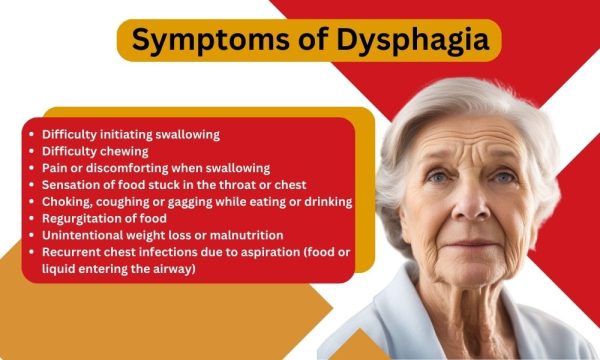Swallowing is a seemingly simple yet intricately coordinated process that we do over 600 times a day without thinking. But for many people, swallowing isn’t so simple.
Dysphagia, or difficulty swallowing, can affect people of all ages, significantly impacting a person’s quality of life by turning this basic function into a frustrating and potentially dangerous challenge.
Dysphagia is common and can range from mild discomfort to severe impairment. It can arise from neurological conditions such as stroke or Parkinson’s disease, muscular disorders like myasthenia gravis, structural abnormalities in the throat or oesophagus (food tube), cancer, advanced age, or as a side effect of certain medical treatments such as radiation therapy.

Symptoms of dysphagia may include:
- Difficulty initiating swallowing
- Difficulty chewing
- Pain or discomforting when swallowing
- Sensation of food stuck in the throat or chest
- Choking, coughing or gagging while eating or drinking
- Regurgitation of food
- Unintentional weight loss or malnutrition
- Recurrent chest infections due to aspiration (food or liquid entering the airway)
Living with Dysphagia

Dysphagia can significantly impact a person’s quality of life, making eating and drinking challenging and potentially leading to malnutrition and dehydration. Speech Pathologists are specially trained to support people with swallowing difficulties by providing assessment, diagnosis, management, and treatment that may include:
- Dietary modifications: recommending texture modifications for food and liquids, ensuring safe and nutritious consumption. Thickening agents or pureed diets might be used as needed.
- Swallowing exercises: focusing on strengthening and retraining the muscles involved in swallowing to improve coordination and efficiency.
- Postural techniques: optimising body positioning during swallowing can enhance effectiveness and reduce the risk of aspiration.
- Compensatory strategies: teaching techniques to compensate for difficulties, like head positioning, effortful swallows, or specific manoeuvres.
- Education and support: educating individuals and caregivers about dysphagia management, including safe swallow strategies and potential risks.
References:
Groher, M. E., & Crary, M. A. (2010). Dysphagia: Clinical management in adults and children. Mosby.
Pietsch, K., Lyon, T., Dhillon, V. K. (2018). Speech language pathology rehabilitation. Med Clin North Am, 102(6), 1121-1134. doi:10.1016/j.mcna.2018.06.010.
Thiyagalingam, S., Kulinski, A. E., Thorsteinsdottir, B., Shindelar, K. L., Takahashi, P. Y. (2021).
Dysphagia in older adults. Mayo Clin Proc, 96(2), 488-497. doi:10.1016/j.mayocp.2020.08.001.
Wilkinson, J. M., Codipilly, D. C., & Wilfahrt R. P. (2021). Dysphagia: evaluation and collaborative management. Am Fam Physician, 103(2), 97-106.

